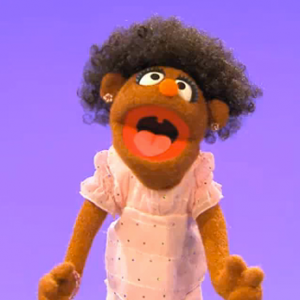Don’t need a trip to the beauty shop, ’cause I love what I got on top.
It’s curly and it’s brown and it’s right up there!
You know what I love? That’s right, my hair!
I really love my hair.
I love my hair. I love my hair.
There’s nothing else that can compare with my hair.
I love my hair, so I must declare:
I really, really, really love my hair.
Wear a clippy or in a bow
Or let it sit in an afro
My hair looks good in a cornrow
It does so many things you know, that’s why I let it grow
I love my hair, I love my hair
I love it and I have to share
I love my hair, I love my hair!
This is a song that I can’t stop singing…and for so many reasons!
If you haven’t seen or heard about the You Tube video “I Love My Hair” that’s produced by Sesame Street, you must. All I can say as a 40 year-old woman with unruly, curly, dark hair is “Hallejeullah!” I had so much angst over my head of hair, which I sometimes called a mop on my head. There’s a lot of viral talk online about how encouraging this video has been to black girls and women who have the same curly locks issues, but I haven’t read about the reactions from other white women like myself who grew up with the same kind of nappy hair. That’s the great appeal of the video – it speaks to all of us who have hair issues in our lifetimes…I being one of them.
This video has been posted all over the place- on Afrobella, The Fashion Bomb, Styleite, Fly, Essence, The Huffington Post, CNN and there are loads of comments all over You Tube, Facebook and Twitter, both positive and negative. The You Tube video has gotten nearly 800,000 hits and now Willow Smith, Will Smith’s Daughter, has come out with a follow-up song and video called “Whip Up Hair” (which Sesame Street also produced a follow-up You Tube video in response to rather quickly) which is drawing even more attention to the original video. Personally, I prefer the original but love the way that the nine-year-old is bringing attention to little girl’s self esteem issues.
Joey Mazzarino, the head writer at Sesame Street, created this song for his adopted daughter from Ethiopia, Segi. He says he has watched her struggle with her curly hair issues and it’s daily struggles. She looks at her barbies with straight, silky hair and wonders why she looks different than they do.
So where was this video when I was growing up? I used to stare at my dolls’ hair and wonder why I, too, looked so different. When I was in 3rd grade, I woke up one day to a whole new head of hair. I went from having straight, fine brown hair to curly, kinky, unruly hair. It literally looked like I’d been electrocuted. My hair no longer matched anyone else in my family – my sisters had smooth, straight hair. My mom kept her own hair short, but there was no afro when she let it grow. She didn’t know how to handle my new hair.
For years I wore a headband or ponytail. My hair embarrassed me. It didn’t know which way to go, up or down. It was hard to brush and terribly hard to manage. Going to the hair dresser was more agonizing than going to the doctor. I would have rather had surgery than a haircut, I kid you not. The stylists didn’t even know what to do with my hair and would inevitably say the wrong thing about it, sending me home in tears. One day we were in a hotel lobby in downtown Atlanta, and there was a conference for African American women about hair products. We talked to some people and found out what products they were using to calm down their hair. That was all I wanted to do, calm my hair down, make it straight and fine. So, then my mom started taking me to salons in downtown Atlanta to get my hair relaxed, using strong chemicals. My hair smelled like hot oil and the results backfired.
Finally, later in high school, my mom found a hair dresser who had hair like mine. She agreed to do my hair in her apartment. She finally told me my problem with my hair: I had to let it go, let it do whatever it needed to do, let it go free. My hair wasn’t meant to be up in a ponytail, it wasn’t meant to be pushed underneath a headband. I had big, curly hair that needed to go wild. She taught me to love it and I found newly formed curls, and on the days that it would go into an afro, I embraced my differences. She changed my life.
After I moved to New York as an adult, I discovered curly hair products like Ouidad, Curlisto and now Devachaun. I have been going to stylists who specialize in curly hair since I moved here and I’ve embraced my hair. I love it. Some days are better than others, particularly when it’s humid or raining. It doesn’t always look good, but it’s mine. It’s part of my identity – a little quirky, a little unpredictable, a little spontaneous – just like me.
But as a child, it embarrassed me. I didn’t look like anyone in my family. I sure wish I had this video to let me know that I wasn’t alone. Even then, I was stuck with the same images that African American children have to deal with – barbies with straight blonde hair and Disney princesses with straight tresses. Now we all know what needs to happen: we need barbies and princesses with nappy hair!
While writing this piece, a few books come to mind that teach this same kind of lessons to kids:
Nappy Hair by Carolivia Herron
The Colors of Us by Karen Katz
We’re Different, We’re the Same and We’re All Wonderful by Bobbi Kates
This video is exactly what all children need. It projects an image of a girl who accepts herself for who she is. I hope that its message reaches little girls across the globe. We all need to embrace who we are.
How do you feel about this video? Can you relate to my childhood? Please comment and tell me. It’s so good to know when you’re not alone.

























Hi friends, good post and good urging commented here, I am truly
enjoying by these.